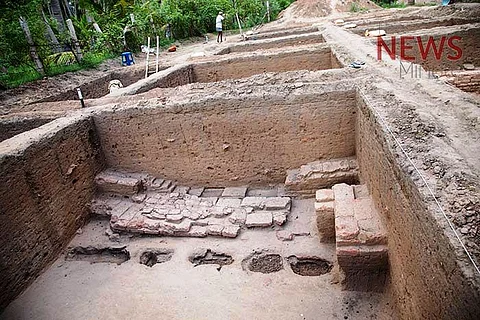

Follow TNM’s WhatsApp channel for news updates and story links.
Amid its ongoing tussle with the Union government over the antiquity of Keezhadi, the Tamil Nadu Department of Archaeology has requested the Archaeological Survey of India (ASI) to approve excavations at seven new sites across the state.
The proposed sites include: an ancient Buddhist vihara at the Chola port town of Nagapattinam; a Sangam-era glass bead production centre at Manikollai in Cuddalore district; locations where Roman gold coins were discovered, including Vellalur in Coimbatore and Karivalamvanthanallur in Tenkasi; an Iron Age burial site at Adichanur near Tirukoyilur; another Iron Age site at Thelunganur in Salem; and a conch-shell ornament-making unit at Pattinamarrudur in Thoothukudi district.
The state has also sought approval to launch the 11th phase of excavation at Keezhadi near Madurai, stressing that less than 4% of the settlement has been explored so far.
Explaining the selection of the new sites, the department said it plans to collaborate with the Field Museum in Chicago and Indian Institute of Technology (IIT), Gandhinagar, to study the glass beads found at Manikollai. These artefacts, now classified as Indo-Pacific monochrome beads, have also been discovered in Han dynasty graves in China and at sites in Thailand and Vietnam, suggesting possible origins in Tamil Nadu.
Excavating the Chudamani Vihara at Nagapattinam, which dates back to the 11th century, could also shed light on the maritime trade networks of the Chola empire.
The demand for new excavations comes amid political tensions over Keezhadi, located near Sivaganga district. Excavations began under the ASI in 2014, with the first two phases led by archaeologist Amarnath Ramakrishna. These digs unearthed thousands of artefacts, including Tamil-Brahmi inscriptions, pottery kilns, terracotta objects, and evidence of large-scale textile production and trade. The findings challenged long-held narratives that placed South India’s urbanisation only after the Mauryan expansion.
However, in 2017, following Ramakrishna’s transfer, the ASI halted the third phase of excavation, citing “no significant findings” in a report authored by archaeologist PS Sriraman. Excavations resumed in 2018 under the Tamil Nadu State Department of Archaeology (TNSDA), after a Madras High Court order, and have since yielded more than 15,000 artefacts.
In January 2023, Ramakrishna submitted a 982-page report on the first two phases to the ASI. In May 2025, the ASI returned the report, asking for revisions and raising objections to the early dating of the site. Ramakrishna, citing Accelerator Mass Spectrometry (AMS) dating and stratigraphic analysis, refused to alter his conclusions.
In June, Union Minister for Culture and Tourism Gajendra Singh Shekhawat dismissed the report as “not technically well supported” and called for further scientific validation, sparking protests from historians, archaeologists, and political parties in Tamil Nadu.
In July, the Union government tasked PS Sriraman, the same archaeologist who had earlier reported “no significant findings”, to draft the official report for the third phase. This move has heightened concerns over the credibility and intent of the review process.
Ramakrishna and other experts argue that the material culture unearthed at Keezhadi bridges the chronological gap between the Indus Valley Civilisation and early South Indian urbanisation.